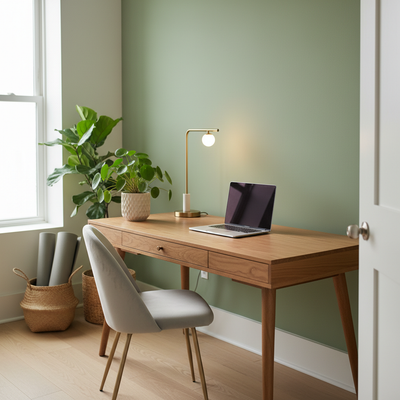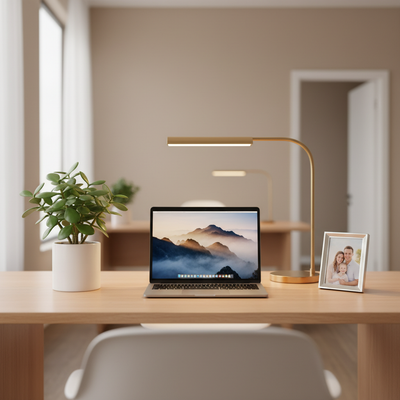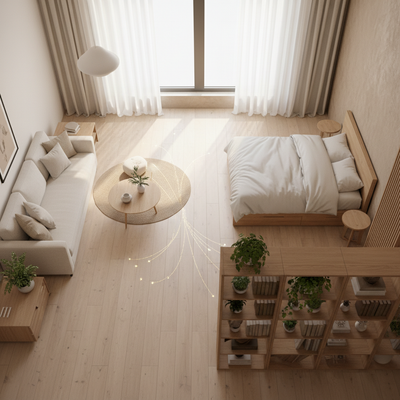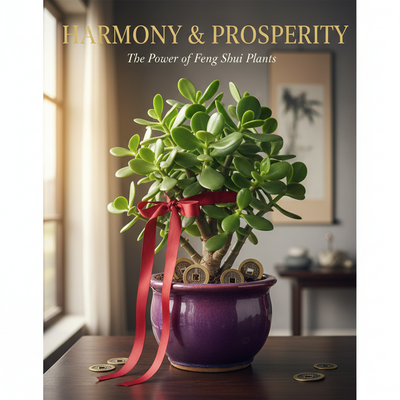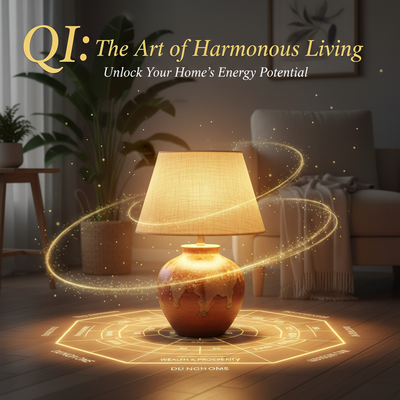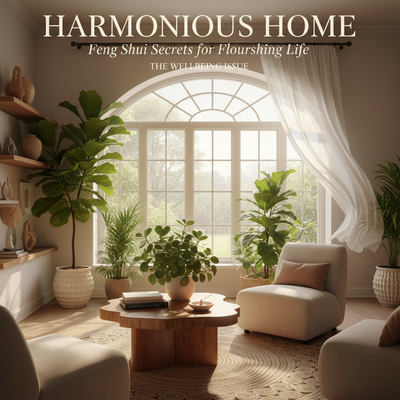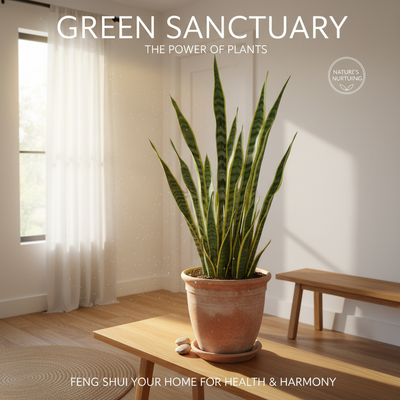You have a deadline coming up, a tough problem to solve, or an exam to study for. You sit down at your desk, ready to work, but your mind starts to wander. The space feels boring, even draining. You find yourself putting things off, getting distracted easily, and unable to find that deep focus you need. This is a common problem, but the answer might be right in front of you: the colors around you. Using feng shui study room colors in the right way can change a space from something that distracts you into a powerful place for getting things done.
This guide is your plan for creating a space that helps you reach your goals. We will go beyond just making things look nice to explore the energy ideas of Feng Shui, giving you the power to pick colors that actually work for you. We'll start by understanding the 'why'—the main ideas of Qi and the Five Elements. Then, we'll look at the 'what'—a detailed list of the best colors for focus and learning. Finally, we'll master the 'how'—giving you practical, real-world ways to use these colors for the biggest impact. Get ready to unlock your potential by creating a study space that helps you focus better, be more creative, and succeed in school.
The Foundation of Color

In Feng Shui, color is not just decoration; it is a living expression of Qi (pronounced "chee"), the vital life force energy that brings everything to life. Different colors vibrate at different frequencies, affecting the energy of a room and, as a result, our own mood, behavior, and mental clarity. Understanding two basic ideas—the Five Elements and Yin/Yang balance—is the key to using color effectively.
The Five Elements—Wood, Fire, Earth, Metal, and Water—are the building blocks of Feng Shui. Each element is connected with specific colors, energies, qualities, and goals. A balanced environment includes these elements thoughtfully.
Yin and Yang describe the two-sided nature of Qi. Yang energy is active, bright, and expansive (think bright colors), while Yin energy is passive, dark, and calming (think soft tones). A study room needs a careful balance. Too much Yang can lead to burnout and worry, while too much Yin can result in sluggishness and a lack of motivation. The goal is a mostly Yin environment (calm and focused) with just enough Yang to stimulate the mind.
This table provides a clear overview of the Five Elements and their color connections.
| Element | Associated Colors | Energy & Aspiration |
|---|---|---|
| Wood | Green, Brown | Growth, Vitality, New Beginnings |
| Fire | Red, Strong Yellow, Orange, Purple | Passion, Energy, Transformation |
| Earth | Light Yellow, Sandy/Earthy Tones, Beige | Stability, Nourishment, Grounding |
| Metal | White, Gray, Metallic Hues | Clarity, Precision, Logic, Efficiency |
| Water | Blue, Black | Wisdom, Calm, Flow, Social Connections |
The Productivity Palette
Choosing the right color is the most important decision you can make for your study's energy. Here are the most effective feng shui study room colors, chosen for their ability to promote focus, clarity, and mental stamina.
Blues & Greens for Calm Focus
This combination is the clear winner for study and office spaces. Representing the Water and Wood elements respectively, blue and green create a combination of calm intelligence and vibrant growth.
Blue is the color of the Water element, connected with wisdom, peace, and depth. Color psychology studies have consistently shown that blue has a calming effect on the nervous system, lowering blood pressure and reducing feelings of stress. This makes it perfect for tasks requiring deep thought and a peaceful state of mind.
* Promotes a sense of calm and peace.
* Reduces stress and mental worry.
* Helps with thinking and deep thought.
* Shades like soft sky blue are excellent for walls, while a deeper navy can be a powerful accent.
Green, the color of the Wood element, represents growth, renewal, and vitality. It's the color of nature, and bringing it indoors connects us to this healing energy. Importantly for a study, scientific research has found that looking at the color green can reduce eye strain, a significant benefit for anyone spending long hours reading or looking at a screen.
* Encourages new ideas and personal growth.
* Soothes the eyes, reducing tiredness.
* Creates a sense of balance and harmony.
* Consider shades like sage green, mint, or a deep forest green for a studious atmosphere.
Earth Tones for Grounding
Beige, taupe, sandy colors, and soft yellows belong to the Earth element. The main quality of Earth energy is stability, grounding, and nourishment. These colors create a solid, supportive foundation for your work.
Unlike stark white, which can feel clinical and draining, warm earth tones provide a nurturing backdrop that doesn't compete for your attention. They allow your mind to settle, making them perfect for long-term projects and remembering information. A soft, buttery yellow is particularly helpful as it gently stimulates the mind without being over-exciting.
* Creates a stable and secure feeling.
* Nurtures focus over long periods.
* Acts as a neutral, non-distracting background.
* Excellent for main wall colors in a room that needs a sense of warmth and support.
Off-Whites & Grays for Clarity
While pure, stark white can be harsh, off-whites and light grays are powerful tools from the Metal element. The energy of Metal is about precision, logic, efficiency, and clarity. These colors help you cut through mental clutter and organize your thoughts.
An off-white or a very light gray acts like a clean slate for the mind, allowing new information to be processed without interference from the surrounding environment. They are sophisticated, clean, and promote a sense of order. These colors are particularly effective for work that requires analytical thinking, problem-solving, and attention to detail.
* Promotes mental precision and order.
* Helps to cut through confusion and mental fog.
* Creates a clean, uncluttered feeling.
* Perfect for simple spaces or for those who are easily over-stimulated by color.
Colors to Use with Caution
Just as some colors support focus, others can actively work against it. In Feng Shui, no color is naturally "bad," but some have powerful energies that are not well-suited for a space dedicated to focus. Use these colors sparingly, if at all.
-
Strong Red: As a Fire element color, red is pure Yang energy. It's connected with passion, action, and even aggression. While a tiny accent can provide a motivational boost, too much red in a study can lead to over-stimulation, worry, restlessness, and mental burnout. It's the color of "fight or flight," not "sit and study."
-
Dark Blue/Black: These are Water element colors. While blue is calming, too much dark blue or black can create an overwhelmingly Yin environment. This can lead to feelings of sluggishness, depression, or a sense of being "drowned" in work. Use them as grounding accents (e.g., a picture frame or a desk chair), not as the main color.
-
Bright Orange/Yellow: Like red, these are high-energy Fire element colors. They are cheerful, social, and stimulating—excellent for a kitchen or playroom, but highly distracting in a study. They encourage conversation and activity rather than quiet thinking.

- Dark Brown: While brown is a Wood element color, very dark, heavy browns can make a space feel stagnant and oppressive if overused. This can stifle creativity and make it difficult for new ideas to flow. Choose lighter wood tones or use dark brown in small, grounding doses, like a single piece of furniture.
Personalizing Your Palette
General recommendations provide a great starting point, but for truly best results, the best feng shui study room colors are tailored to your specific space and goals. This is where we move to the next level of Feng Shui application.
Aligning with the Bagua Map
The Bagua is the energy map of your home, an octagon divided into nine areas, each corresponding to a different aspect of life (like Career, Knowledge, or Wealth). The direction your study is located in your home's floor plan can help you choose the most supportive colors. To find your study's location, stand at your front door looking in and overlay a tic-tac-toe grid on your home's layout.
| Study Location (Bagua Area) | Life Aspect | Governing Element | Supportive Colors |
|---|---|---|---|
| North | Career & Life Path | Water | Blue, Black |
| Northeast | Knowledge & Self-Cultivation | Earth | Beige, Sandy Tones, Light Yellow |
| East | Family & New Beginnings | Wood | Green, Brown |
| Southeast | Wealth & Abundance | Wood | Green, Purple, touches of Red |
| South | Fame & Reputation | Fire | Red, Orange, Strong Yellow |
| Southwest | Love & Relationships | Earth | Pinks, Reds, Earth Tones |
| West | Children & Creativity | Metal | White, Gray, Metallics |
| Northwest | Helpful People & Travel | Metal | White, Gray, Black |
For example, if your study falls in the Northeast "Knowledge" sector, using Earth tones like beige or soft yellow will directly enhance the room's natural energy for learning and self-improvement.
Goal-Oriented Color Palettes
You can also create "color recipes" based on your specific professional or academic goals. This is a highly effective way to program your environment for success.
For Deep Focus & Analytical Work (e.g., programming, research, editing):
Your goal is precision and uninterrupted thought. Create a palette dominated by the Metal and Water elements.
* Dominant: Light Gray or Off-White (Metal for clarity and precision).
* Secondary: Deep Blue (Water for wisdom and calm).
* Accent: A touch of metallic silver or black (to ground the space and sharpen focus).
For Creativity & Idea Generation (e.g., writing, design, brainstorming):
Your goal is to foster new ideas and connections. Create a palette based on the Wood element, supported by Water and Metal.
* Dominant: Off-White (Metal for a 'blank slate' mind).
* Secondary: Shades of Green (Wood for growth and new ideas).
* Accent: Turquoise (a creative blend of blue's calm and green's vitality) or a small, inspiring piece of art.
For Knowledge Retention & Exams (e.g., students, certification prep):
Your goal is to absorb and retain information. Create a nurturing palette using the Earth and Wood elements.
* Dominant: Soft Yellow or Sandy Beige (Earth to nourish the mind and support retention).
* Secondary: Light Green (Wood for mental growth and learning).
* Accent: A healthy plant (the ultimate Wood element) or desk accessories in earthy tones.
From Theory to Reality
Choosing your colors is only half the battle; application is everything. A thoughtful implementation strategy ensures your chosen palette creates a harmonious and effective space, not a chaotic one.
The 60-30-10 Rule
This classic interior design principle is a perfect tool for applying Feng Shui colors in a balanced way. It prevents any one color from overwhelming the space.
* 60% Dominant Color: This is your main color, typically used on the walls. It should be one of your primary supportive colors, like a soft blue or a warm beige.
* 30% Secondary Color: This color should complement the dominant one and is used for larger items like furniture, curtains, or an area rug.
* 10% Accent Color: This is your power color, used in small doses to add energy or a specific quality. Think cushions, artwork, lamps, or even stationery. This is the perfect place for a pop of motivational red or wise black.
Weaving Color Through Decor
Paint is powerful, but it isn't the only way to introduce color. Weaving your palette through various textures and objects adds depth and sophistication to your Feng Shui design.
* Furniture: A light wood desk brings in the Wood element. A gray ergonomic chair introduces the precision of the Metal element.
* Textiles: Curtains and rugs can carry your secondary color, while throw pillows or a blanket can serve as your accent.
* Artwork: Select art that not only features your chosen colors but also reflects the themes of your work—be it landscapes for growth or abstract pieces for creativity.
* Lighting: Lamps with colored bases or shades can subtly reinforce your color scheme.
* Stationery & Desk Accessories: Your notebooks, pen holders, and mousepad are easy and effective ways to bring in your 10% accent color.
Light and Decluttering
Remember that no color can work its magic in a dark, cluttered room. Qi needs light and space to flow.
* Maximize Natural Light: Keep windows clean and unobstructed. Good lighting activates the colors in the room and energizes the space.
* Declutter Ruthlessly: A cluttered desk and room create stagnant energy, blocking focus and promoting stress. A clean, organized space allows Qi—and your thoughts—to flow freely.
We recently worked with a client, a PhD student, whose study was in the 'Knowledge' (Northeast) sector of their home but was painted a stark, cold white. They felt stuck and uninspired. By repainting the main walls in a warm, sandy beige (Earth element) and adding a vibrant green plant (Wood element to control Earth and add life) and blue accents in their stationery (Water for wisdom), they reported a significant boost in their ability to focus and retain information. This shows how a thoughtful combination of feng shui study room colors can make a real difference.
Seeking Expert Guidance
While these principles can create profound change, some spaces present inherent Feng Shui challenges, such as irregular room shapes, poor natural light, or a difficult location on the Bagua map. In these situations, a simple color change may not be enough to harmonize the energy fully.
For these complex scenarios, a one-on-one consultation offers a tailored solution. A professional analysis considers factors beyond general principles, such as the homeowner's personal Kua number (an energetic profile based on birth year), the building's orientation, and specific life goals. For instance, the THE QI FLOW team often helps clients harmonize their study spaces by analyzing the interaction between the room's energy and the individual's personal energetic blueprint, recommending precise adjustments that go far beyond a simple coat of paint to unlock peak performance and well-being.
Your Blueprint for Success
Creating a high-performance study room is an act of intention. By consciously choosing your colors, you are building an environment that actively supports your ambitions. You now have the blueprint to make that happen.
Here are your key takeaways:
* Start with a foundation of calm, supportive colors like blues, greens, and earth tones to promote focus and reduce stress.
* Personalize your palette by considering the room's Bagua location and your specific academic or professional goals.
* Remember that implementation matters: use the 60-30-10 rule and incorporate color through decor, not just paint, for a balanced and sophisticated space.
* Always prioritize natural light and a clutter-free environment to allow positive Qi to circulate.
Your ideal study space is within your reach. A well-chosen feng shui study room colors scheme is more than just interior design—it's a powerful tool for unlocking your focus, creativity, and ultimate success.

